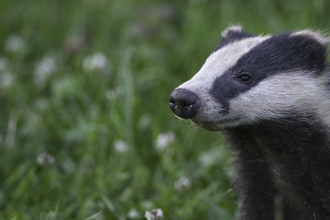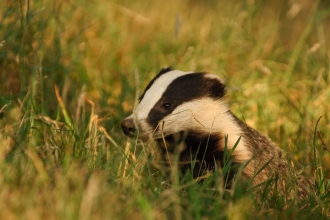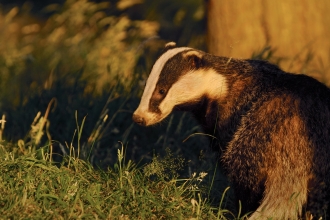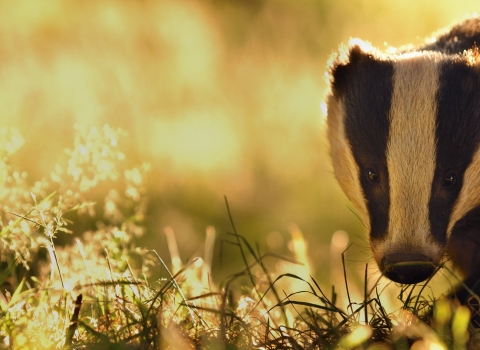Worcestershire Wildlife Trust was extremely disappointed to hear that, following a public consultation earlier in the year, the Government announcement at the end of May 2021 that licenses to kill badgers until 2026 will continue to be issued. This puts a further 130,000 animals at risk of being shot.
The 2022 cull could see up to 68,000 badgers being killed in a total of 69 places.
The Government has failed to listen to the public who want an immediate end to the badger cull. A further 130,000 badgers culled in addition to the badgers already culled represents 60% of England’s badger population and their culling will have repercussions on the health of natural habitats because badgers are vital to a thriving ecosystem. 25% of the European badger population is found in the UK, we believe that the UK has an international responsibility to conserve them.
We believe that the Government needs to speed up the promised transition from culling to vaccination.
We recognise the hardship that bovine TB causes in the farming community and the need to find the right mechanisms to control it. We want to see the Government prioritise badger vaccination, alongside a comprehensive package of cattle measures: better biosecurity, stricter movement controls, improved TB testing and development of a cattle vaccine. The Wildlife Trusts are one of several groups and organisations already deploying one of the tools for tackling bTB – badger vaccination.
Worcestershire Wildlife Trust opposes the badger cull and we will not allow culling to take place on our land.
The evidence is clear; the pilot culls have been ineffective and inhumane.Director
What is bovine tuberculosis?
Bovine tuberculosis (bTB) is a highly infectious disease of cattle that devastates thousands of farming businesses annually. Since the mid-1980s, the incidence of bTB in cattle has increased substantially, creating an economic burden on the taxpayer and the farming industry as infected cattle must be culled.
Government research shows that TB is not a major cause of death in badgers. Generally, infected badgers do not show any sign of infection and can survive for many years before suffering from severe emaciation.
Why are badgers being culled?
Badgers are being culled as part of a government initiative to reduce the spread of bovine tuberculosis (bTB) in cattle. Pilot badger culls commenced in 2013 in Gloucester and Somerset amid much opposition. An Independent Expert Panel (IEP) was appointed by Defra to assess the effectiveness, humaneness and safety of the 2013 culls. The panel deemed the culls 'ineffective' and 'inhumane' in 2013, with no significant improvement - and further failures - in 2014. Despite two parliamentary debates, a prominent opposition campaign and the support of numerous experts and high-profile figures, the number of areas increased in 2015 to include Dorset. In August 2016, the Government announced seven new cull licenses across three new areas (Cornwall, Devon and Herefordshire).
In September 2017 the Government licensed 11 new areas and authorised two new supplementary licenses in Gloucestershire and Somerset. This brought the total number of badger cull areas to 21. In total, 19,274 badgers were culled in the 2017 badger cull in England.
In August 2022 the Government licenced 11 new areas – including in counties such as Buckinghamshire and Northamptonshire for the first time. Culling is taking place in a total of 69 places in Avon, Berkshire, Buckinghamshire, Cornwall, Cheshire, Derbyshire, Devon, Dorset, Gloucestershire, Hampshire, Herefordshire, Oxfordshire, Leicestershire, Lincolnshire, Northamptonshire, Shropshire, Somerset, Staffordshire, Warwickshire, Wiltshire and Worcestershire. Information published alongside the new licences states that, to achieve the 70% reduction in badger population that Defra wants to see in cull areas, up to nearly 68,000 badgers could be shot this year.
What does Worcestershire Wildlife Trust believe?
Together with other Wildlife Trusts, we are very conscious of the hardship that bovine TB (bTB) causes in the farming community and the need to find the right ways to control the disease. However, we believe that a badger cull is not the answer. The scientific evidence demonstrates that culling is likely to be ineffective and risks making the problem even worse. Badgers are not the primary cause of the spread of bTB in cattle – the primary route of infection is from cattle-to-cattle. There is work being done to accelerate the introduction of an effective cattle vaccine and improved bTB testing in cattle – these offer the best long-term way to reduce bTB in the cattle population. We believe the emphasis of all our efforts should be to find a long-term solution and we are calling for the Government to end its policy of culling badgers.
- This is a cattle problem, not a badger problem.
The control of bovine TB in cattle should be the main focus of everyone’s efforts to control this problem. The evidence shows that badgers are not the primary cause of the spread of TB in cattle: the primary route of infection is via cow-to-cow contact. Studies indicate that bTB transmission may occur via contaminated pasture or around farm buildings but a study by the Food and Environment Research Agency concluded that simple exclusion measures are 100% effective in preventing badgers entering farm buildings when deployed properly. - A vaccine for cattle should be a priority.
Cattle vaccination offers the best long-term way to reduce bTB in the cattle population. The research, testing and trialling of a vaccine has been completed but it is not yet technically called a vaccine in this country as it has to be accredited. However, accreditation for the European market cannot be progressed whilst an EU ban remains in place on the use of such a vaccine. The ban exists because BCG vaccination of cattle can interfere with the tuberculin skin test, which is the recognised primary diagnostic test for TB in cattle. A test called a DIVA test could help resolve this issue. - Badger vaccinations should be extended.
Badger vaccination has the potential to reduce badger-to-cattle transmission by lowering the prevalence of infection in the badger population. Vaccination does not remove infected badgers, but it does reduce their ability to infect other badgers (that are protected by the vaccine). Over time, the infected animals should die off, and the prevalence of infection would be expected to decline. - The cull is scientifically unsound.
The results of the previous badger culls indicate that this policy is flawed and unsupported by the evidence. In 2014 scientist and badger expert Rosie Woodroffe deemed the cull ‘scientifically rubbish’ in response to changing Government targets. Culling has been shown to be more expensive, less effective than other Bovine TB (bTB) control mechanisms and the free-shooting of badgers has been shown to be an inhumane method of killing.
What about badgers and protected sites?
In September, Defra published a series of documents, Annex B, on restrictions to badger culling on protected sites within a 20km radius of each cull zone. One of these documents referred to Sites of Special Scientific Interest (SSSI) in Worcestershire. Inclusion in Annex B does not mean that the badger cull is taking place on the site; it simply means that the protected site is within 20km of the cull zone.
In addition, the cull will not go ahead in any county that does not have an authorisation letter attributed to them. Worcestershire does not have an authorisation letter.
We reiterate that we will not allow badger culling to take place on our land.
Natural England have issued the following statement:
Natural England undertake full and detailed assessments of the likely ecological impact of cull operations for all protected sites within each badger control area and up to 20km from the boundaries of each area.
Particularly for sites with mobile features, assessments are necessary whether or not cull operations are actually intended within them. The conclusions of these assessments inform the conditions that would need to be applied should badger control operations be undertaken within or adjacent to individual protected sites. These conditions are part of the badger control licence annexes.
To be as transparent as possible, we have published the licences and the unredacted annexes together on gov.uk. These are released on a county basis.
Protected sites that are within the assessment are not necessarily part of any active cull operations. Active operations can and will only occur on protected sites where landowner/occupier permission has been granted. Inclusion of sites on this list does not indicate whether or not permission has been granted by the land owner.
What can you do to help?
We are urging people to write to their MPs asking them to help stop the cull. (Find your MP here.)

Vaccines for badgers and cattle are urgently needed
Colin explains why we need the UK Government to speed up its promised transition from badger culling to vaccination in England…

Government U-turn on promises to end badger culling
We have confirmation of the latest badger cull authorised this autumn by Government. This is the largest ever seasonal cull and will…

Badgers win reprieve
At last the government has announced that culling of badgers will be halted and replaced by vaccination – just what we have been calling…

